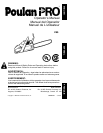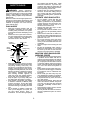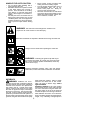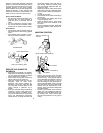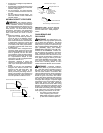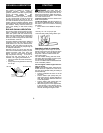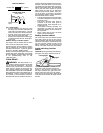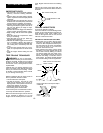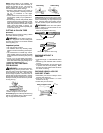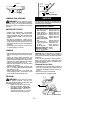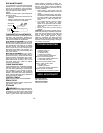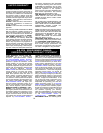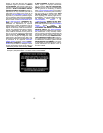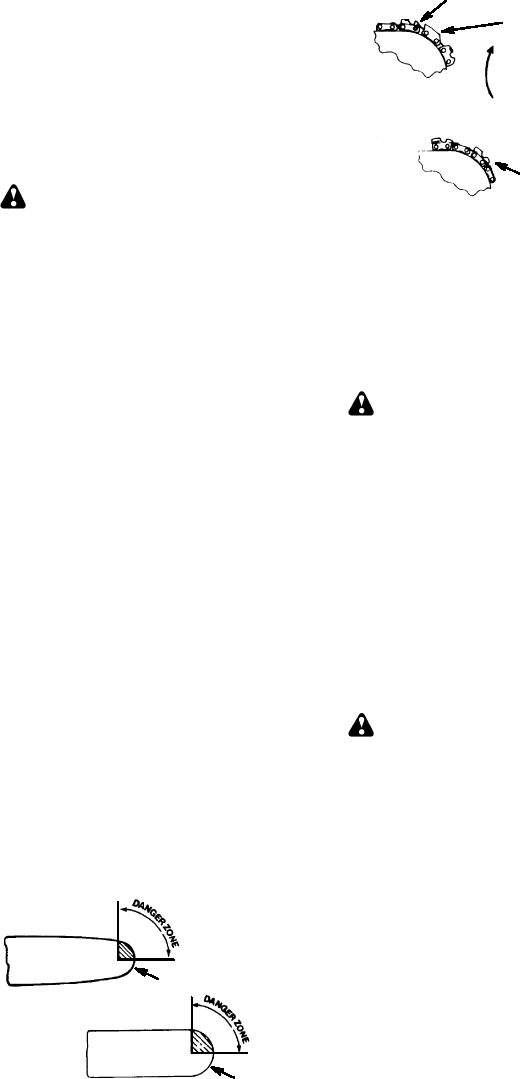
5
S
Stand with your weight evenly balanced
on both feet.
S
Stand slightly to theleft side ofthe saw to
keep your body frombeing ina direct line
with the cutting chain.
S
Do not overreach. You could be drawn
or thrown off balance and lose control of
the saw.
S
Do not cut above shoulder height. It is
difficult t o maintain control of saw above
shoulder height.
KICKBACK SAFETY FEATURES
WARNING:
The following features
are included on your saw to help reduce the
hazard of kickback; however, such features
will not totally eliminate this dangerous reac-
tion. As a chain saw user, do not rely only on
safety devices. You must follow all safety
precautions, instructions, and maintenance
in this manual to help avoid kickback and
other forces which can result in serious
injury.
S
Reduced--Kickback Guide Bar, de-
signed with a small radius tip w hich re-
duces the size of the kickback danger
zone on the bar tip. A Reduced--Kick-
back Guide Bar has been demonstrated
to significantly reduce the number and
seriousness of kickbacks when tested
in accordance with safety requirements
for gasoline powered chain saws as set
by ANSI B175.1.
S
Low--Kickback Chain, designed with a
contoured depth gauge and guard link
which deflect kickback force and allow
wood to gradually ride into the cutter.
Low--Kickback Chain has m et kickback
performance requirements w hen tested
on a representative sample of chain
saws below 3.8 cubic inch displacement
specified in ANSI B175.1.
S
Handguard, designed to reduce the
chance of your left hand contacting the
chain if your hand slips off the front han-
dlebar.
S
Position of front and rear handlebars,
designed with distance between han-
dles and “in-line” with each other. The
spread and “in-line” position of the
hands provided by this design work to-
gether to give balance and res istance in
controlling the pivot of the saw back to-
ward the operator if kickback occurs.
Small Radius Tip
Symmetrical Guide Bar
Reduced Kickback Symmetrical Guide Bar
Large Radius Tip
Low---Kickback
Chain
Chain With High Kickback Potential
Can Obstruct Material
Contoured Depth Gauge
Elongated Guard Link
Deflects
Kickback Force
And Allows Wood
To Gradually
Ride Into Cutter
ANSI B175.1-1991
“American National
Standard for Powered Tools -- Gasoline
Powered Chain Saw -- Safety Require-
ments.”
CHAIN BRAKE AND
CKA ANGLE
WARNING:
The effectiveness of a
chain brake in reducing operator injuries has
not yet been fully determined. We cannot
represent that a chain brake is an effective
safety device to prevent or reduce the haz -
ard of injuries r esulting from kickback.
DO
NOT ASSUME THAT THE CHAIN
BRAKE WILL PROTECT YOU IN THE
EVENT OF A KICKBACK.
Instead, use
the saw properly and carefully to avoid kick-
back. Reduced--Kickback bars and Low--
Kickback chains reduce the hazard of kick-
back and are recommended. Repairs on a
chain brake should be made by an Autho-
rized
POULAN PRO
Service Dealer. Take
your unit to the place of purchase if pur-
chased from a Servicing Dealer, or to the
nearest Authorized Master Service Dealer.
WARNING:
Computed kickback
angle (CKA) listed on your saw and listed in
the CKA table below represents angle of
kickback your bar and chain combinations
will have when tested in accordance with
CSA and ANSI standards. When purchasing
replacement bar and chain, considerations
should be given to the lower CKA values.
Lower CKA values represent safer angles to
the user, higher values indicate more angle
and higher kick energies. Computed angles
represented in the non-activated column in-
dicate total energy and angle associated
without activation of the chain brake during
kickback. Activated angle represents chain
stopping time relative to activation angle of
chain break and resulting kick angle of saw.
In all cases lower CKA values represent a
safer operating environment for the user.
S
Tip contact in some cases may
cause a lightning fast reverse
REACTION, kicking the guide bar
up and back toward the operator.



